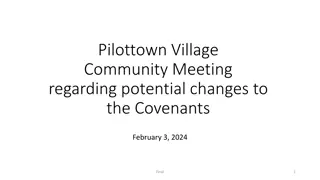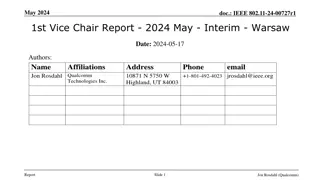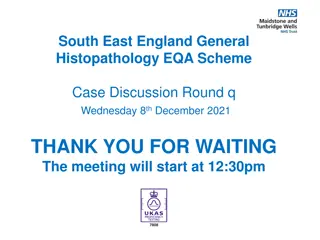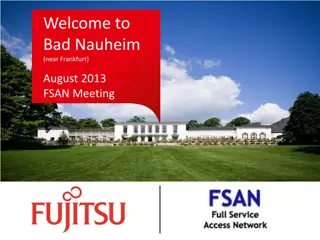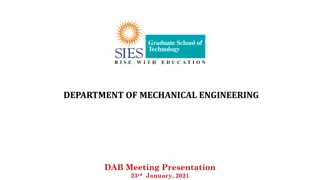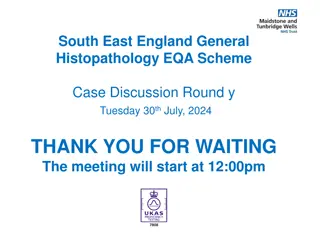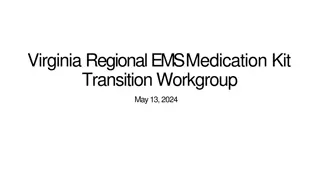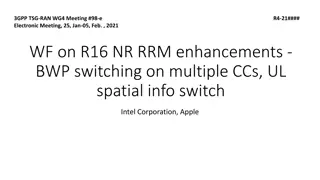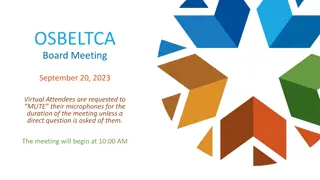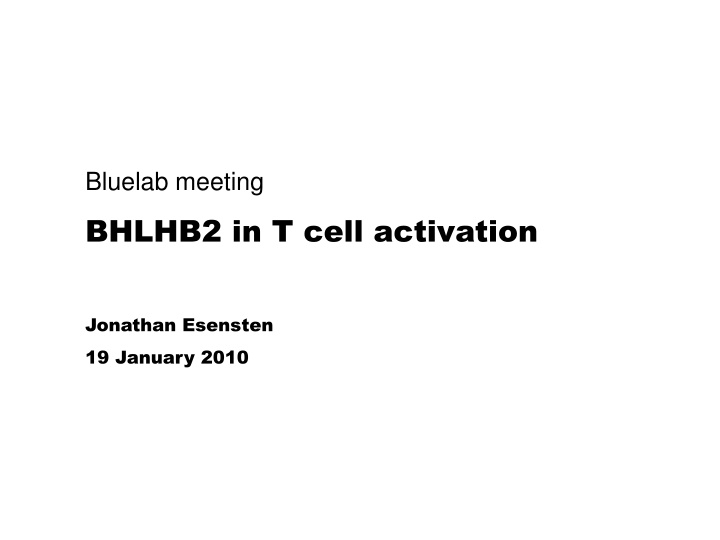
Distinct T Cell Activation Program: BHLHB2 Transcription Factor Study
Explore the role of the BHLHB2 transcription factor in T cell activation, examining how co-stimulation via CD28 affects T cell phenotype and differentiation. Discover insights from shRNA targeting BHLHB2 mRNA and its impact on primary cells. Details on epitope-tagged BHLHB2 expression and the competitive advantages observed with BHLHB2 over-expression in Jurkat cells.
Download Presentation

Please find below an Image/Link to download the presentation.
The content on the website is provided AS IS for your information and personal use only. It may not be sold, licensed, or shared on other websites without obtaining consent from the author. If you encounter any issues during the download, it is possible that the publisher has removed the file from their server.
You are allowed to download the files provided on this website for personal or commercial use, subject to the condition that they are used lawfully. All files are the property of their respective owners.
The content on the website is provided AS IS for your information and personal use only. It may not be sold, licensed, or shared on other websites without obtaining consent from the author.
E N D
Presentation Transcript
Bluelab meeting BHLHB2 in T cell activation Jonathan Esensten 19 January 2010
Hypothesis: co-stimulation via CD28 during activation induces a distinct T cell phenotype and differentiation program that is controlled by one or more transcription factors.
Top mRNA hit: BHLHB2
shRNAs were designed to target 3 locations in the BHLHB2 mRNA: 2455 1088 502 3 Bhlhb2 mRNA 5 An additional scrambled (SCRM) hairpin sequence was cloned into pSICO-R vector (with constitutive GFP). Vector was packaged into lenti virus.
Unfortunately, this shRNA construct does not appear to work in primary cells.
[. . .] Also: Senior author of Sun et al emailed us saying that the autoimmune disease that they reported disappeared when then moved to an SPF mouse facility.
CD4+ cells from BHLHB2 +/+ or -/- littermates were purified from splenocytes and activated under the indicated conditions for 24 hours before harvest IFN (relative) IL-2 (relative) 80% of WT 40% of WT anti-CD3 - + + - + + anti-CD3 - + + - + + anti-CD28 - - + - - + anti-CD28 - - + - - + BHLHB2 +/+ BHLHB2 -/- BHLHB2 +/+ BHLHB2 -/- Cells courtesy of Ann Marini and Robert Lipsky
Epitope-tagged BHLHB2 expression vector for ChIP AMP CMV TATA box Rep origin 1 5' LTR (RU5) HIV env/gp8 HIV Intergrase (Flap) pCSP NEP FugW.GAD.TCR164 091009 Exon-1 11672 bp hUBC-1 Exon-2 GAD164 alpha BamHI 3' LTR P2A WPRE GAD165 beta EGFP structure of the inserts eGFP 2A hBHLHB2 6xHIS A2 EcoRI eGFP 2A hBHLHB2 B1
BHLHB2 over-expression gives Jurkat cells a competitive advantage. . .at lease initially
Jurkat cells were sorted for GFP+ fraction 3 days after infection pre-sort uninfected post-sort 5.4% 6xHIS-tagged 1.5% untagged GFP
Day 12 post-sort 6xHIS-tagged untagged uninfected 0.1% 99.2% 97.6%
Poor activation using anti-CD3 and anti-CD28 with large numbers of cells 24hrs, anti-CD3 + aCD28 unstimulated 6xHIS-tagged untagged CD69 CD25
PMA and ionomycin stimulation 24hrs, PMA + ionomycin unstimulated 6xHIS-tagged untagged CD69 CD25
qPCR on Jurkat cells infected with pFUGW-eGFP-2A-BHLHB2, ativated with P+I, JE 1-8-09 1000000 expression relative to unstimulated 100000 10000 1000 100 10 1 CD25 un CD25 act IL-2 un IL-2 act BHLHB2 unBHLHB2 act
fragmented DNA from chromatin prep 800 500 400 average: ~300 bp 300 200 100 A2-activated, 2 ug A2-activated, 8 ug A2-unstim, 2 ug A2-unstim, 8 ug
First results. . . ChIP of IL-2 locus and control loci in Jurkat cells infected with BHLHB2-6xHIS, JE 1-15-10 0.045 0.04 enrichement relative to input 0.035 0.03 0.025 0.02 0.015 0.01 0.005 0 neg control pos control IL-2 exon 3 IL-2 promoter
Could the primers be the problem? IL-2 promoter: product: 376 bp IL-2 intron 3: product: 307 bp Chr. 8 origin negative controlmyc1: product: 249 bp Rev-erba (DEC1 positive control)product: 401 BP
Troubleshooting the ChIP asssay - primers product is too large - epitope is blocked during fixation - antibody not binding to protein A - non-specific binding to beads requires more washing
Next steps Mouse work - Confirm IL-2 production defect in the naive CD4+ cells from BHLHB2 KO mice - Basic activation and proliferation assays - Investigate possible Treg defects
Thank you Jeff Bluestone David Gumbiner Weihong Liu Amy Putnam Todd Eagar Donors B-G Dimitri de Kouchkovsky Art Weiss Shirley Zhu Chris Barker Jennifer Gregg the entire Bluestone and Anderson labs


